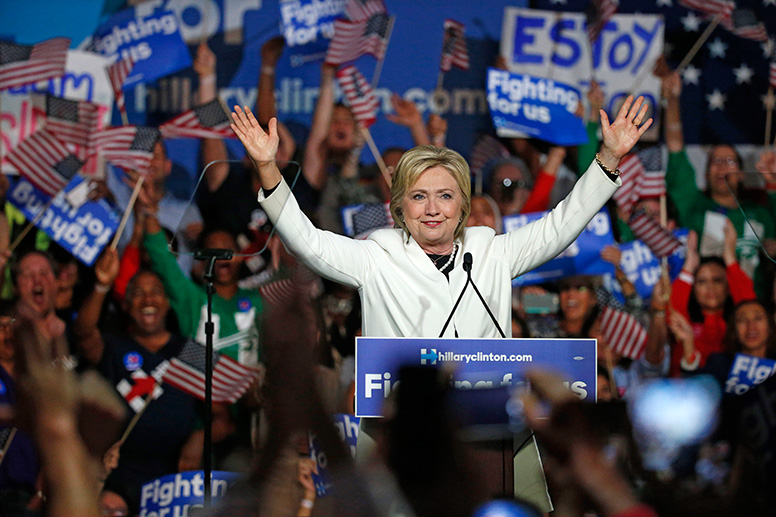

 Article
Article

 Darden Professor Kim Whitler breaks down the brand positioning of presidential campaigns and explains why some are more successful from a marketing standpoint.
Darden Professor Kim Whitler breaks down the brand positioning of presidential campaigns and explains why some are more successful from a marketing standpoint.

Insights from
Written by
From “Tippecanoe and Tyler, Too” in 1840 to “Change We Can Believe In” in 2008, the use of branding in presidential campaigns is almost as old as the United States itself. In fact, from a marketing perspective, presidential candidates are not so different from consumer products.
Developing a brand starts with determining a superior position — what you want to stand for, relative to competitors, that matters to consumers. For example, Walmart’s position is centered on lower prices that enable consumers to save money. And just as brands use taglines to communicate the essence of their positioning (e.g., Walmart’s “Save Money. Live Better” tagline), political candidates use brand slogans throughout their campaigns to stake out their position.
In the 2016 primaries, four distinctly “branded” leading presidential candidates — Democrats Hillary Clinton and Bernie Sanders and Republicans Donald Trump and Ted Cruz — all had different positions they attempted to establish and own in the minds of consumers (i.e., voters). While the marketing success of a presidential candidate requires far more than slogans and advertising (what candidates do and say does matter!), this assessment serves as a simple view of the candidates’ brand positioning and ignores the other side of creating a successful brand — that of behavior and commercialization.
So whose positions seemed strongest? Start by looking at each candidate’s tagline to understand his or her position and compare it to what matters most to voters. Just as Barack Obama’s position in 2008, centered on delivering change, was more effective than John McCain’s “Country First” at identifying what voters most wanted, some candidates have done a better job this election cycle. Having a superior position is the first step. The next step is ensuring that voters know and remember what that position is. Those two components together help reveal who has the marketing savvy this election season, and who is falling short.

Tagline: Hillary for America
Assumed Consumer Belief: Everyday Americans need someone to fight for them.
Benefits to Voters: Clinton is a known quantity who will fight for America.
Candidate’s Proof Points: Clinton has experience as U.S. secretary of state, U.S. senator and first lady. She has demonstrated her ability to lead at the highest level, navigating difficult situations and crises. She will continue the legacy that President Obama started.
Brand Image1: Decisive (50%), Compassionate (41%), Honest (29%), Inspiring (38%), Likable (37%), Competent (48%), Could Possibly Win General Election (71%)
Tagline Unaided Awareness2: 21% had an idea of tagline; 8% knew tagline exactly
Summary: The essence of Clinton’s brand positioning is that she will fight for America and everyday Americans. However, this positioning does not necessarily align with her brand image. One might expect a “champion” for “everyday Americans” to be viewed very favorably by voters as someone who cares about them. However, Bernie Sanders is well ahead of Clinton in ratings on compassion, honesty and likability — all attributes required to “own” a positioning that is anchored on effectively fighting for everyday Americans. Having been in the spotlight for decades, Clinton’s brand image is most likely based on historical actions and less on her campaign positioning. Whereas for the newcomers, the actual positioning weighs more heavily on brand image ratings.
While Clinton’s experience is a differentiator to the other candidates in the race (which is good), she failed to harness this fact and convert it into a benefit for the voter during primary season. Her brand positioning left voters to determine for themselves how her experience would improve everyday Americans’ lives. A central tenet of marketing is to be clear — don’t force your consumers (or voters) to infer what you mean, because many won’t guess correctly. On the bright side, Clinton’s history in the limelight helps her generate awareness at a lower cost and provides her a big pulpit to reinforce her positioning as the champion for everyday Americans moving forward.
Taglines: A Political Revolution Is Coming
Assumed Consumer Belief: Americans want revolutionary political change to ensure the right future.
Benefits to Voters: Sanders’ Democratic-Socialist-principles-driven revolution will create the future Americans want.
Candidate’s Proof Points: Sanders is a Democratic Socialist. He has a long track record of pushing for social programs to iron out economic and social inequalities.
Brand Image1: Decisive (47%), Compassionate (52%), Honest (49%), Inspiring (43%), Likable (48%), Competent (44%), Could Possibly Win General Election (62%)
Tagline Unaided Awareness2: 31% had an idea of tagline; 8% knew tagline exactly
Summary: Sanders launched his campaign with the slogan “A Political Revolution Is Coming” when he was a virtual unknown, then “Feel the Bern” went viral as he drew in a movement of young voters, helping establish the 74-year-old’s surprisingly hip image. As the candidate’s coalition of support began to look more like that of Barack Obama in 2008, the Sanders campaign shifted to “A Future to Believe in,” bearing undeniable similarity to Obama’s “Change We Can Believe in” from 2008. From a brand positioning standpoint, however, consistency matters. Shifting slogans can confuse the voter and muddy the consumer benefit Sanders is proposing to solve as well as the benefits he offers voters.
Perhaps surprising given how relatively unknown he was on the national stage before primary season, there was stronger unaided awareness of Sanders’ tagline than Clinton’s. The Vermont senator’s successful pre-primary campaigning created rising awareness at rates far higher than the already well-known Clinton and Trump or any of the other Republican candidates, according to a recurring AP-GfK Poll. Sanders’ standing among voters as the most compassionate, honest, inspiring and likable of any candidate, combined with his fervent commitment to Democratic Socialist idealism, proved to be an intoxicating cocktail for voters, particularly young voters.
Assessing the candidates’ understanding of the mood of the electorate (i.e., consumer belief), their abilities to establish superior positioning through their slogans and how well they raised awareness of their positioning, Sanders and Trump both turned in strong performances during primary season, largely because they both captured the sentiment those within their parties were most passionate about. Clinton’s efforts have been somewhat mixed. Cruz arguably succeeded with his positioning, although that positioning was only effective for a small portion of the population. Trump did the clearest job creating a superior position that connected deeply with the sentiment of his target, all while driving the highest awareness at the lowest cost.
For Darden Professor Kimberly A. Whitler’s analysis of Republican presidential campaign positioning, please see the companion to this piece, “Branders-in-Chief, Part 1: Republican Presidential Campaigns.”
1 “Very” or “somewhat” – responses to The Associated Press-GfK Poll conducted by GfK Public Affairs & Corporate Relations from 11 to 15 February 2016. Poll surveyed 1,033 adults with 46 percent response rate, 43 percent of respondents identifying as Democrats or Democrat-leaning, 37 percent identifying as Republican or Republican-leaning and 20 percent identifying as “don’t lean.”
2 Based on an unaided awareness test of Darden supporters and friends conducted by Darden Professor Kim Whitler. Sample size = 86
Whitler is an authority on marketing, with expertise in marketing strategy, brand management, and marketing performance. Her research centers on understanding how a firm’s marketing performance is affected by its C-suite and board.
A prolific writer as well as researcher, Whitler has authored nearly 100 articles related to C-level marketing management challenges and is a contributor for Forbes and CMO.com. Social Media Marketing Magazine named her one of the Top 100 Marketing Professors on Twitter.
Whitler has held leadership roles, including GM and CMO positions, within the consumer packaged goods and retailing industries, including Procter & Gamble, David’s Bridal and PetSmart. She has helped build $1B+ brands, including Tide, Bounce, Downy and Zest.
B.A., Eureka College; MBA, University of Arizona Eller School of Business; M.S., Ph.D., Indiana University Kelley School of Business